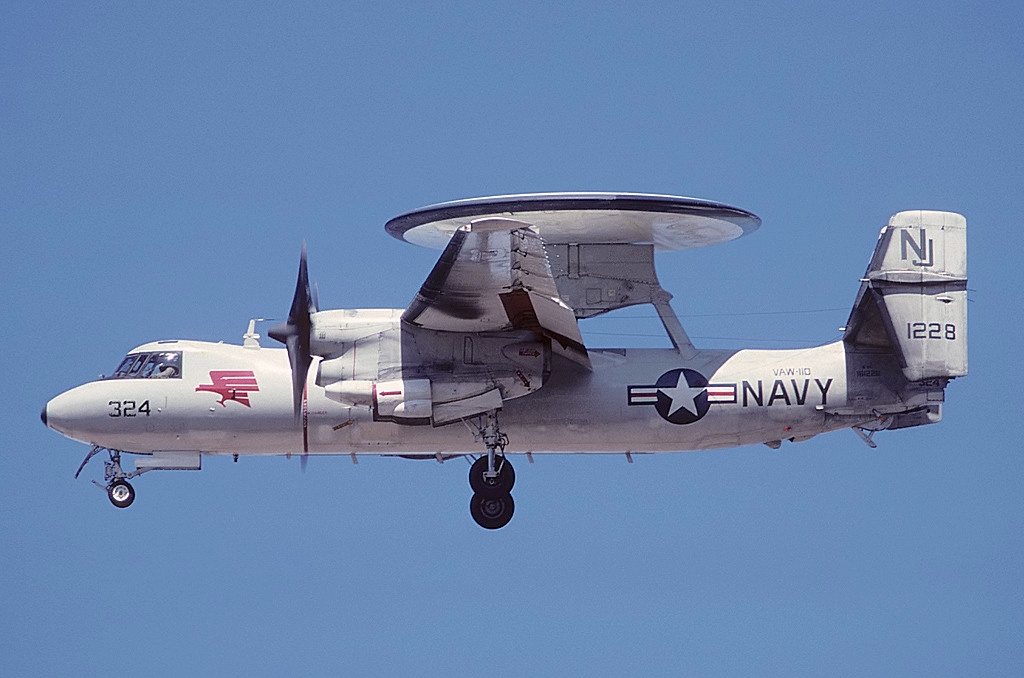VAW-110 on:
[Wikipedia]
[Google]
[Amazon]
Carrier Airborne Early Warning Squadron 110 (VAW-110), nicknamed the "Firebirds", was an aviation unit of the
 In late 1987, VAW-110 began training personnel for the
In late 1987, VAW-110 began training personnel for the
United States Navy
The United States Navy (USN) is the maritime service branch of the United States Armed Forces and one of the eight uniformed services of the United States. It is the largest and most powerful navy in the world, with the estimated tonnage ...
based at NAS Miramar
Marine Corps Air Station Miramar (MCAS Miramar) , formerly Naval Auxiliary Air Station (NAAS) Miramar and Naval Air Station (NAS) Miramar, is a United States Marine Corps installation that is home to the 3rd Marine Aircraft Wing, which is the avi ...
.The Firebirds were a training squadron for the E-2 Hawkeyes. It was disestablished in September 1994.
Squadron History
It had its beginnings on 20 April 1967 as Replacement Airborne Early Warning Squadron 110 (RVAW-110), which had been formed when VAW-11 was broken into six separate squadrons. In spite of its primary role in training, RVAW-110 acquired operational skills through deployments aboard the aircraft carriers , , and during theVietnam War
The Vietnam War (also known by other names) was a conflict in Vietnam, Laos, and Cambodia from 1 November 1955 to the fall of Saigon on 30 April 1975. It was the second of the Indochina Wars and was officially fought between North Vietnam a ...
. RVAW 110 was known as the rag outfit and it was the training arm of the Airborne Early Warning Squadrons. It consisted of E-1B's and E-2A's. It was stationed at NAS North Island before later moving to NAS Miramar.
1960s
In July 1966, VAW-12 received the first E-2A Hawkeye, and was supplying detachments utilizing two different aircraft aboard ten Atlantic Fleet aircraft carriers in addition to training personnel for those detachments. With over 200 officers and 800 enlisted personnel, VAW -12 was reorganized as an Air Wing, and on 1 April 1967, Admiral T.E. Moore,Commander in Chief, U.S. Atlantic Fleet
The United States Fleet Forces Command (USFF) is a service component command of the United States Navy that provides naval forces to a wide variety of U.S. forces. The naval resources may be allocated to Combatant Commanders such as United Stat ...
, commissioned Carrier Airborne Early Warning Wing Twelve with six operating squadrons.
1970s
The squadron received the second generation E-2B Hawkeye aircraft in 1970, followed by the arrival of the E-2C on 31 May 1980. With the delivery of the first Advanced Radar Processing System (ARPS) aircraft in 1978, RVAW 110 trained Naval Flight Officers (NFOs), Flight Technicians and maintenance personnel in both the APS-120 and APS-125 radars. This continued until 1980 when all east coast VAW squadrons completed transition to the APS-125.1980s
In May 1980, the 2F110 Operational Flight Trainer (OFT) was delivered and ready for use in early May 1981. The OFT is designed to simulate actual in-flight emergencies and train Replacement Pilots to handle such emergencies prior to receiving E-2C training flights. The 15F8B Weapon System Trainer(WST) arrived in October 1984 and was accepted for training on 19 November 1984. This latest arrival provided staff and Replacement NFOs with the latest technology for the Grumman Hawkeye. In late 1987, VAW-110 began training personnel for the
In late 1987, VAW-110 began training personnel for the Grumman C-2 Greyhound
The Grumman C-2 Greyhound is a twin-engine, high-wing cargo aircraft designed to carry supplies, mail, and passengers to and from aircraft carriers of the United States Navy. Its primary mission is carrier onboard delivery (COD). The aircraft p ...
carrier onboard delivery
Carrier onboard delivery (COD) is the use of aircraft to ferry personnel, mail, supplies, and high-priority cargo, such as replacement parts, from shore bases to an aircraft carrier at sea. Several types of aircraft, including helicopters, have ...
aircraft. Later it also trained crews for new variants of the E-2C Hawkeye
The Northrop Grumman E-2 Hawkeye is an American all-weather, carrier-based aircraft, carrier-capable tactical Airborne early warning and control, airborne early warning (AEW) aircraft. This twin-turboprop aircraft was designed and developed duri ...
.
1990s
After more than 27 years of service under two designations, VAW-110 was disestablished on 30 September 1994. Its duties were assumed byVAW-120
Airborne Command & Control Squadron 120 (VAW-120) is a United States Navy Fleet Replacement Squadron responsible for training crews on the E-2 Hawkeye and the C-2A(R) Greyhound.
Squadron history
The squadron was originally established on 6 ...
.
In popular culture
The unique firebird patch for VAW-110 was adapted for use in the films '' Top Gun'' (1986) and '' Top Gun: Maverick'' (2022). The firebird emblem is used in the films to denote the fictional VF-1 Navy flight squadron to which characters Pete "Maverick" Mitchell (Tom Cruise
Thomas Cruise Mapother IV (born July 3, 1962), known professionally as Tom Cruise, is an American actor and producer. One of the world's highest-paid actors, he has received various accolades, including an Honorary Palme d'Or and three Go ...
) and Nick "Goose" Bradshaw ( Anthony Edwards) belong.
The emblem can be seen on the characters' flight helmet, Mitchell's motorcycle and a few other places.
See also
*History of the United States Navy
The history of the United States Navy divides into two major periods: the "Old Navy", a small but respected force of sailing ships that was notable for innovation in the use of ironclads during the American Civil War, and the "New Navy" the ...
* List of inactive United States Navy aircraft squadrons
There are hundreds of US Navy aircraft squadrons which are not currently active dating back to before World War II (the U.S. Navy operated aircraft prior to World War I, but it did not organize them in squadrons until after that war). To be mo ...
References
{{DEFAULTSORT:Vaw-110 Early warning squadrons of the United States Navy